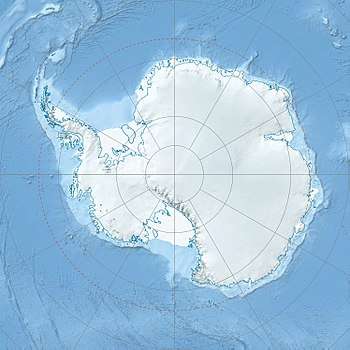Mercer Lake (Antarctica)
Mercer Subglacial Lake is a subglacial lake in Antarctica covered by a sheet of ice 1,067 m (3,501 ft) thick; the water below is hydraulically active, with water replacement times on the order of a decade from the Ross Sea.
| Mercer Subglacial Lake | |
|---|---|
| PPT-16 | |
 Mercer Subglacial Lake Location in West Antarctica | |
| Location | West Antarctica |
| Coordinates | 84.661°S 149.677°W [1] |
| Type | Subglacial lake |
| Ocean/sea sources | Ross Sea |
| Max. length | 9 km (5.6 mi) |
| Surface area | 160 km2 (62 sq mi)[2] |
| Average depth | 10–15 metres (33–49 ft) [2] |
| Residence time | ~10 years |
Mercer Subglacial Lake is identified as high risk for a collapse of the West Antarctic Ice Sheet caused by global warming.[3] Studies suggest that Mercer Subglacial Lake as well as other subglacial lakes appear to be linked, with drainage events in one reservoir causing filling and follow-on drainage in adjacent lakes.[4]
Exploration
Helen Amanda Fricker from the Scripps Institution of Oceanography discovered subglacial Mercer Subglacial Lake in 2007, while using satellite laser altimetry to search for the grounding line of a glacier.[5] The lake is named after Mercer Ice Stream (formerly Ice Stream A), beneath which the lake is located. Mercer Ice Stream is named after the late Ohio State University glaciologist John Mercer. On 28 December 2018, the Subglacial Antarctic Lakes Scientific Access (SALSA) team,[6] where she serves on the executive committee of the project,[5] announced they had reached Mercer Subglacial Lake after two days of melting their way through 1,067 m (3,501 ft) of ice with a high-pressure hot-water drill.[7] The drill water is run through filters that catch 99.9% of bacteria and particles,[8] followed by UV light exposure and Pasteurization.[9] The team obtained water samples for chemical and biological analyses, as well as samples of basal ice, and sediment cores as deep as 1.7 m (5 ft 7 in).[5]
Preliminary results
A preliminary report states that ancient carcasses of crustaceans and a tardigrade were isolated from the sediment samples.[10] The lake water samples contains enough oxygen to support aquatic animals, and bacteria are present with a density of at least 10,000 cells per millilitre. Other ancient organisms retrieved from the sediments include shells of diatoms (a photosynthetic algae) and thread-like plants or fungi. How the crustaceans and tardigrade reached Lake Mercer is a matter of debate, but the scientists suspect that the gradual uplift of the continent transformed shallow ocean bays into isolated lakes.[10] The team will attempt to establish the age of the animal remains using radiocarbon dating, and will also try to sequence DNA from crustaceans to find out whether they belong to marine or freshwater species.[10]
The sediment cores will also be analysed by geobiologists to study how relict organic matter deposited during marine incursions influences contemporary biodiversity and carbon cycling.[5]
See also
References
- Wright, Andrew; Siegert, Martin (December 2012). "A fourth inventory of Antarctic subglacial lakes". Antarctic Science. 24 (6): 659–664. doi:10.1017/S095410201200048X. ISSN 0954-1020.
- Scientists explore the mysterious Antarctic lake in less than 3,500 feet of ice to find out if life exists. 1 January 2019.
- Marine ice sheet instability. Bethan Davies, Antarctic Glaciers.org. 16 September 2014.
- Connected subglacial lake activity on lower Mercer and Whillans Ice Streams, West Antarctica, 2003–2008. PDF) Helen Amanda Fricker, and Ted Scambos. Journal of Glaciology, Vol. 55, No. 190, 2009.
- Scientists find new evidence of life beneath Antarctic ice. Andrew Freedman, Axios Science. 17 January 2019.
- Subglacial Antarctic Lakes Scientific Access (SALSA). Montana State University. Accessed on 1 January 2019.
- Maddie Scientists Just Melted a Hole Through 3,500 Feet of Ice to Reach a Mysterious Antarctic Lake. Maddie Stone, Gizmodo. 31 December 2018.
- Scientists explore Antarctic lake 'twice the size of Manhattan' buried under 3,500 feet of ice. Jennifer Earl, Fox News. 31 December 2018.
- Mercer Subglacial Lake - Scientific Stewardship. SALSA. Accessed on 19 January 2019.
- Fox, Douglas (2019-01-18). "Tiny animal carcasses found in buried Antarctic lake". Nature. 565 (7740): 405–406. doi:10.1038/d41586-019-00106-z. PMID 30670855.
External links
- Subglacial Antarctic Lakes Scientific Access (SALSA) home page.
.svg.png)